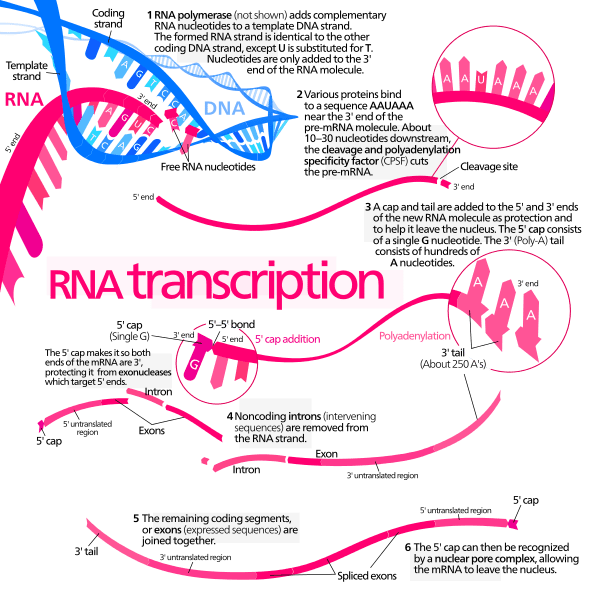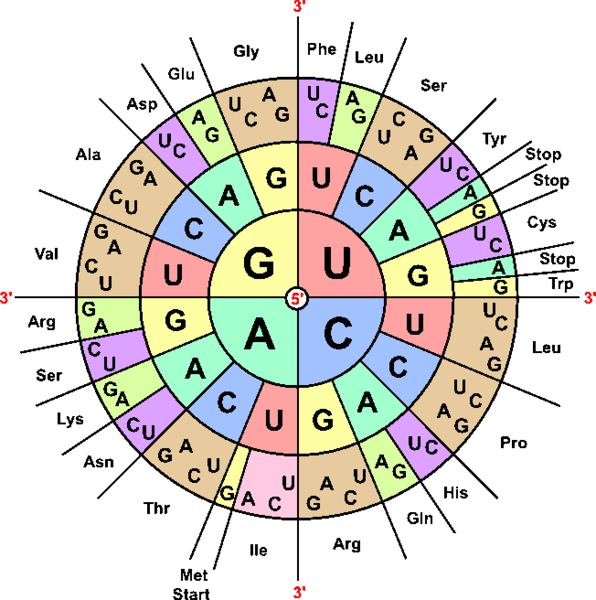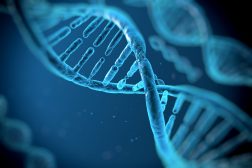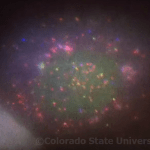Table of Contents
In biology, transcription is the process of transcribing or making a copy of the genetic information stored in a DNA strand into a complementary strand of RNA (messenger RNA or mRNA) with the aid of RNA polymerases. In prokaryotes, the process occurs in the cytoplasm. In eukaryotes, it takes place inside the nucleus. The general steps of transcription are (1) initiation, (2) promoter escape, (3) elongation, and (4) termination. In brief, the RNA polymerase together with certain transcription factors binds to the DNA promoter. This causes the part of the DNA to unwind and form a transcription bubble. A site in the transcription bubble binds to the RNA polymerase. A phase of abortive cycles of short mRNA transcripts are produced and released. The RNA polymerase escapes the promoter to proceed to the elongation step where mRNA transcript is formed while traversing the noncoding strand of the DNA. In the last phase, the hydrogen bonds of the RNA-DNA helix break. In eukaryotes, the mRNA transcript goes through further processing. It goes through polyadenylation, capping, and splicing. After this, the mRNA transcript that carries a copy of the coding segment of the DNA is brought to the ribosomal site for translation.
Transcription definition

Transcription is a biological process wherein the mRNA transcript (i.e. a copy of the coding sequence for a particular protein) is produced, generally by transcribing the template strand of the DNA. This transcript serves as a template for the next step of protein biosynthesis, translation, through the help of the enzyme, RNA polymerase. Thus, transcription is regarded as the first step of gene expression and protein biosynthesis.
Etymology
The term transcription came from Latin transcriptiōnem, from trānscrībō, meaning “transcribe”.
Central dogma
The central dogma of molecular biology holds that the genetic information flows from DNA to DNA through the replication and from DNA to mRNA through transcription. mRNA is translated (translation into a protein comprised of a specific sequence of amino acids. The sequence is determined by the sequence of trinucleotide codons. Each codon is a set of three adjacent nucleotides.
Transcription vs. replication
Both transcription and replication are biological processes of producing a copy of DNA. However, the output of replication is an exact copy of DNA whereas in transcription the output is not an exact copy but an mRNA transcript where thymines are replaced by uracils. In replication, the complementary base pairing includes the adenine-thymine (AT) and the guanine-cytosine (GC) base pairings. In transcription, base pairings are adenine-uracil (AU) and guanine-cytosine (GC). In replication, the enzyme involved is DNA polymerase whereas in transcription the enzyme is RNA polymerase. Both replication and transcription proceeds in the 5′ → 3′ direction. But unlike DNA replication, transcription needs no primer to initiate the process. In prokaryotes, both of them occur in the cytoplasm. In eukaryotes, both occur in the nucleus. While replication is a preparatory stage for cell division such as mitosis transcription is the initial stage of gene expression and protein synthesis.
Transcription vs. translation
Both transcription and translation are steps in protein biosynthesis. However, transcription occurs first before translation. Transcription produces mRNA that carries the code to be translated into a specific protein (or polypeptide). The code is a copy of the DNA coding segment. It specifies the specific sequence of amino acids. Thus, the flow of genetic information in transcription is from DNA → mRNA whereas in translation the flow is from mRNA → amino acid or protein. Both processes are assisted by enzymes: RNA polymerase assists in transcription whereas ribozyme in translation. In prokaryotes, transcription occurs in the cytoplasm whereas in eukaryotes it occurs in the nucleus. As for translation, it takes place in the cytoplasm where the ribosomes are located in both prokaryotic and eukaryotic cells.
Genetic code

In biology, a codon refers to any of a set of three adjacent nucleotides that specify for a particular amino acid. For example, Guanine-Uracil-Uracil (GUU) codes for the amino acid valine. The Cytosine-Uracil-Adenine (CUA) codes for leucine. Uracil-Adenine-Adenine (UAA) is a stop codon. The codons of the mRNA complement the trinucleotides in the tRNA. The trinucleotides in the tRNA are called anticodons. For example, the Guanine-Guanine-Guanine (GGG) codon in the mRNA will complementary pair up with the Cytosine-Cytosine-Cytosine (CCC) anticodon of tRNA.
Steps
Transcription is the first step of gene expression, in which a particular segment of DNA is copied into RNA by the enzyme RNA polymerase. Both RNA and DNA are nucleic acids, which use base pairs of nucleotides as a complementary language that can be converted back and forth from DNA to RNA by the action of the correct enzymes. During transcription, a DNA sequence is read by an RNA polymerase, which produces a complementary, antiparallel RNA strand called a primary transcript. As opposed to DNA replication, transcription results in an RNA complement that includes the nucleotide uracil (U) in all instances where thymine (T) would have occurred in a DNA complement. Also unlike DNA replication where DNA is synthesized, transcription does not involve an RNA primer to initiate RNA synthesis. The steps of transcription are as follows: (1) Initiation, (2) Promoter escape, (3) Elongation, and (4) Termination.
Initiation
RNA polymerase, with the assistance of certain transcription factors, binds to the promoter of DNA, forming RNA polymerase-promoter closed complex. This is then followed by the opening (unwinding) of DNA at the promoter region, forming an open complex. The exposed portion of the DNA following the unwinding forms a transcription bubble. RNA polymerase, then, binds to a transcription start site in the transcription bubble. A phase of abortive initiation (cycles of synthesis) occurs resulting in the release of short mRNA transcripts (about 2 to 15 nucleotides).
Promoter escape
The step after initiation is promoter escape. RNA polymerase escapes the promoter so that it can enter into the elongation step.
Elongation
As RNA polymerase traverses the template noncoding strand of the DNA from 3′ → 5′, it facilitates nucleotide base pairing. Nucleotides of the mRNA are added from 5′ → 3′, producing a copy of the non-template coding strand of the DNA, except for the thymine (replaced by uracil). The sugar-phosphate backbone forms through RNA polymerase. Thus, the sugar component of the backbone is a ribose (as opposed to the sugar of DNA, which is a deoxyribose).
Termination
During this phase, hydrogen bonds of the RNA-DNA helix break. In eukaryotes, the mRNA transcript goes through further processing. It goes through polyadenylation, capping, and splicing. The termination mechanism employed by prokaryotes may either be rho-dependent or rho-independent. In eukaryotes, termination involves both the poly A signal and the downstream terminator sequence.
Prokaryotic transcription vs. eukaryotic transcription
In both prokaryotes and eukaryotes, the genetic flow in transcription is from DNA to RNA. Both use RNA polymerase to assist in the process. However, eukaryotes have three types of RNA polymerases (I, II, and III). Prokaryotes have only one type.
While transcription occurs in the cytoplasm of prokaryotes, it takes place in the nucleus of eukaryotes. If the RNA copy contains the coding segment of the DNA it leaves the nucleus as mRNA for translation at the ribosomal site. In bacteria, the mRNA does not undergo processing prior to translation. Thus, the bacterial mRNA lacks the cap and poly A tail. Conversely, in eukaryotes, the mRNA is further processed by the addition of a cap and a poly A tail and splicing prior to translation. Another major difference is that in bacteria transcription and translation can occur simultaneously. In eukaryotes, transcription has to be completed first before translation can proceed. The mRNA produced by prokaryotes is polycistronic, which means a single mRNA could contain more than one gene. In contrast, the mRNA of eukaryotes is monocistronic since a single mRNA can carry only one gene.
Related terms
- Transcription factor
- Reverse transcription
- Transcription factor Sp4
- Transcription factor HES 1
- Oligodendrocyte transcription factor 1
See also
References and further reading
- Prokaryotic vs. Eukaryotic Transcription. (2019). Retrieved from Uwec.edu website: https://www.chem.uwec.edu/webpapers2006/sites/demlba/folder/provseuk.html
- Central Dogma of Biology. (2014). Retrieved from Csbsju.edu website: http://employees.csbsju.edu/hjakubowski/classes/chem and society/cent-dogma/olcentdogma.html
- Translation: DNA to mRNA to Protein Learn Science at Scitable. (2013). Retrieved from Nature.com website: https://www.nature.com/scitable/topicpage/translation-dna-to-mrna-to-protein-393/
- Transcription and translation. (2017, April 26). Retrieved from Uq.edu.au website: https://di.uq.edu.au/community-and-alumni/sparq-ed/sparq-ed-services/transcription-and-translation
- Transcription / Translation. (2019). Retrieved from Iupui.edu website: https://www.biology.iupui.edu/biocourses/N100/2k3ch13dogma.html
- Protein Synthesis. (2019). Retrieved from Elmhurst.edu website: http://chemistry.elmhurst.edu/vchembook/584proteinsyn.html
© Biology Online. Content provided and moderated by Biology Online Editors

